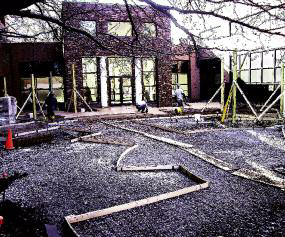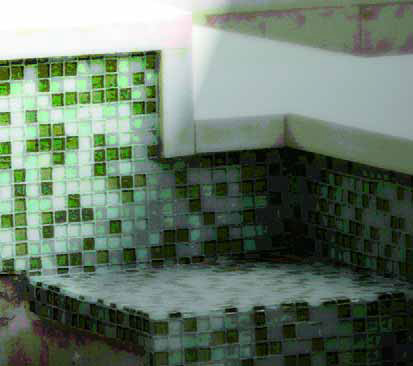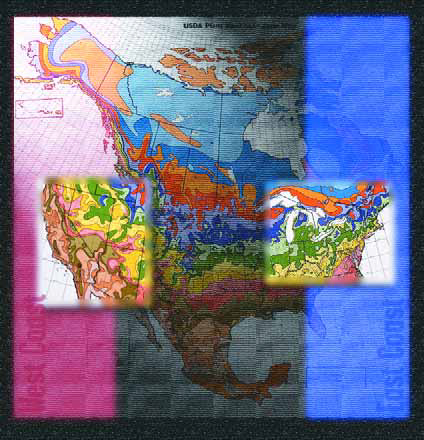walls
How do you define artistry? That’s a highly subjective question, of course, but I’ve always thought of it as a completed work that radiates impressions of insight, effort, skill and mastery — even in
Have you ever noticed how often the costliest part of a project turns out to be something that will ultimately be hidden from view? This happens quite frequently in projects involving any sort of slope, where the piers and grade beams beneath swimming pools, for example, can cost far more than the rest of the overall project. In my own work, I’ve noticed this budgetary quirk most frequently when it comes to retaining walls, where providing the foundation they need to withstand the forces applied by a slope can be startlingly extensive and expensive. It’s not what you’d call glamorous work, but it certainly is important – and will vanish completely from view. Most often, we’re called on to build these walls when
Natural stone is one of the planet's most enduring artistic media and has been used in all historical eras across all design traditions in richly varied ways. From the pyramids of Egypt to the Great Wall of China, from the friezes of the Parthenon to the masterpieces of Michelangelo, it has always been the material of choice for work that matters. For all its beauty and durability, however, natural stone has its limitations: Even in modern times with modern technology, it must be quarried or harvested; fabrication of finished pieces is laborious; and its weight makes moving it from place to place both costly and time-consuming. It's also not a renewable material: Supplies of many of the world's most favored types are restricted, and some are simply no longer available. It's in this context that cast stone has emerged as a viable alternative in reproducing the looks, textures and sheer physical presence of natural stone materials. We at Haddonstone Ltd., for example, offer cast-stone products that can be used in architectural, landscape and watershape settings in ways that are virtually indistinguishable from pieces made of marble or limestone - and do so at a fraction of the cost with a consistency and precision that are difficult to achieve with natural materials. We started modestly in 1971 with a facility near Northampton, England, that turned out just seven ornamental pieces in cast stone. In the ensuing years, that list has grown to include more than
With some details, seeing is believing. That's certainly the case with the one we'll consider in this column, where the images will do much of the work in defining a simple but elegant way of making a statement with any raised bond beam or wall. Yet again, it's testimonial to the good things that happen when watershapers know how to control materials and infuse their work with visual appeal. Most of the time when pool people build small or medium-size walls, they'll automatically be topped with some form of coping or capstone - anything from poured-in-place concrete or stone to brick or some pre-fabricated coping. Many of these walls are
As the first columnist among several who will be writing in this space, I've been elected to explain what this "Material World" thing is all about. I agree with the editors that it does require some explaining - but not much. The thought is that we in the landshaping business, designers and installer alike, seldom use a single material all on its own. Even a huge, monolithic concrete deck outside a grand office building will have ribbons of stone or brick to break up the monotony. The aim of this and subsequent articles - whoever writes them - is to discuss the process we go through in selecting plant and/or hardscape material combinations that ultimately work together to become beautiful and seemingly effortless explorations of style, texture and color. In other words, we'll be looking at projects for which all the
As a landscape designer and installer, I have an abiding fascination with stone. I love the feel of it and its myriad colors, veins, streaks, shapes and textures, and I particularly admire its strength and flexibility. We pave with it, sculpt it and run water over, under and through it. It doesn't need painting or much care, looks great with plant material and has, as those who work with stone will point out, a timeless quality that cannot be reproduced with artificial materials. The best thing about stone is that when you use even one piece in an aesthetically meaningful way, you've
I've been playing with clay for a long time - ever since 1968, when I took my first ceramics class in high school. Clay has captured my imagination mainly with its flexibility: I can carve it, build with it and even color it. For years, I've sculpted pieces of tile out of stoneware and porcelain clay. The individual pieces are then combined to create mosaic compositions, which, among other things, means that I'm able to create works of art that can go just about anywhere and are especially at home in and around water. Now, more than 30 years into working with this wonderful medium as a potter, then as an art student in the United States and Italy and especially in
My daughter and I just returned from our annual trip to visit family in Connecticut and used the occasion this time to travel all over the northeast - from Boothbay Harbor, Portland and Camden in Maine to Martha's Vineyard and Nantucket and other parts of Massachusetts as well as slices of New Hampshire and Rhode Island. I'm never disappointed by the beauty I find in that part of the country. The landscapes are much lusher than they are at home in southern California, a fact that drives home the point that I spend most of my time in a desert. The old-growth trees back east are
If you can't see potential in every backyard you walk into, then you're in the wrong business. Yes, some projects are more inspiring than others, and some spaces seem to offer you more to work with than others. Without exception, however, our clients' yards present us with opportunities to develop programs that take advantage of what's there in ways that bring balance and harmony and interest to any setting. Speaking for myself, I'm no more energized in a project than when I get the opportunity to right a wrong and replace a past mistake with a fresh, interesting design - and that was certainly the case in the project discussed in this article and in my past several "Details" columns in this magazine. The setting was special, the clients were great and I was given free rein to work with color, shape and line in vivid, interesting and even startling ways - all in keeping with their wants and desires. SETTING THE SCENE To recap information from recent "Details," this pool/spa combination with its associated decking, walls, planters, outdoor cooking facilities and private garden area are located in a narrow yard at the base of a slope in Pacific Palisades, Calif. It's a spectacular





















